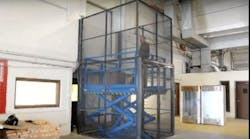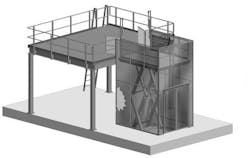When it comes to mezzanine storage, what goes up must come down. If your material handlers can ride with your pallet jacks, this process may become more ergonomic, and faster, too.
That’s the conceit of the rider mezzanine lift, which Advance Lifts refers to as “a dock lift on steroids.” Michael Renken, vice president of sales for Advance Lifts, says these could have some pretty serious performance enhancements over vertical reciprocating conveyors (VRC).
“With a scissors lift instead of a VRC, a person can ride with the product,” Renken explains. “People don’t have to run up and down staircases. They can wheel a pallet jack of product onto the lift, go up to the second level, and wheel it off. What used to be time-consuming and done with two people can now be done with one.”
VRCs are still the dominant method to accessing mezzanines, and Advanced Lifts has recently started supplying those, to complement its rider and non-rider scissor lifts and package lifts. If you’re trying to decide which is best for your material handling operations, here’s what Renken says you should know:
Operation
Obviously, the key component to a rider lift—allowing a rider and the material aboard—literally cuts several steps, (if not flights) from a material handling routine. In a brewery for example, if the rider has to load several kegs onto a lift and walk up to a staircase to put them where they belong, that could get take a lot of time. Over months or years, that could take quite a toll on the handler’s body.
While scissor lifts go about 8 to 10 feet per minute, low-speed VRCs move at 16 to 20 feet per minute, and other VRCs can go up to 100 feet per minute. If your operation involves workers already positioned on the floor and mezzanine, the VRC will make more sense.
Size
The most common rider lift Advanced Lift offers is 6 by 8 feet—good dimensions for wheeling a pallet jack. Custom installs can be larger, reaching 12 by 12 feet. The maximum vertical height is 18 feet.
VRCs are typically smaller, generally running 6 by 6 feet. They can be as small as 3 by 3 feet. and up to 8 x 10 feet. VRCs can ascend more than five times higher than rider lifts, reaching up to 100 feet.
Facility Requirements
Scissor lifts must be pit mounted, so that should be taken into account. “With VRCs, you don’t have to cut a hole in the floor,” Renken says.
The rider lifts come fully assembled, so you just drop them in the pit and attach the hydraulics. An enclosure must also be built. Advanced Lifts 2014 white paper goes into detail on code and enclosure requirements.
One major thing to note: Scissor lifts don’t fall under elevator codes; ANSI MH29.1-2012 is the governing code for industrial scissor lifts, so they don’t require a licensed elevator installer. “That could be three times the cost of a normal installer,” Renken says.
VRCs, which fall under ASME 20.1 products, must be installed by licensed elevator installers in some states. This install can not only cost more but also may take much longer to complete. VRCs, though, can be installed in tight spaces because they are put together on site.
If you don’t require a rider lift, but want to avoid the installation costs, you can also get a non-rider scissor lift, Renken says.











